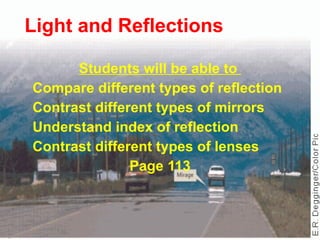Light And Reflections
- 1. Light and Reflections Students will be able to Compare different types of reflection Contrast different types of mirrors Understand index of reflection Contrast different types of lenses Page 113
- 3. Reflection of Light Rays Ray â Straight line wave to represent light 114
- 4. Reflection of Light Rays Two types of Reflection Regular Light hits a smooth surface All rays reflected at same angle Sharp image Diffuse Uneven surface Each ray reflects differently 114
- 6. Plane Mirrors Flat sheet of glass with a smooth silver coating What you see in mirror is virtual image Appears to be behind the mirror Same size and upright Right and left sides are reversed 115
- 8. Concave Mirrors A mirror with a surface that curves inward like a bowl Optical axis =Imaginary line that cut mirror in half Focal point = Point where rays meet The more curved then the closer the focal point 116
- 11. Concave Mirrors Real image is produced when rays meet Always upside down Can be larger or smaller Virtual image if inside focal point Always right side up Always larger 117
- 13. Convex Mirrors Mirror curves outward Always virtual image Always smaller Used in side mirrors of cars Picture large world in small mirror Problem is that everything is small 118
- 15. Refraction Light waves bend when they enter a new medium at an angle 120
- 16. Index of Refraction Measure of how much light bends The higher the number the more it bends light 120
- 17. Prisms and Rainbows Longer wavelength bends least (red on top) Short wavelength bends more (violet on bottom) 121
- 18. Mirages Temperature changes will cause light to change speed (light wave moves faster in when hot) 121
- 19. Lenses Lens = Curved piece of glass to refract light 122
- 20. Convex Lens Thicker in the center than the edges Can produce virtual or real images depending on location 122
- 21. Convex Lens 122
- 22. Concave Lens Thicker on the edges than in the middle Only virtual images 122
- 23. Quiz
- 24. Homework Describe one type of mirrors and one type of lens























